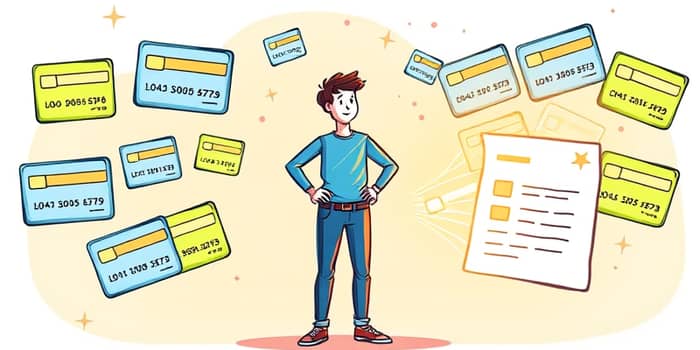
Juggling several credit cards with mounting balances and rising interest rates can feel like constantly running on a treadmill—no matter how fast you go, you never seem to get ahead. The financial and emotional strain of tracking different due dates, calculating minimum payments, and facing sky-high APRs can wear anyone down.
Fortunately, there is a strategy used by many financial experts to break the cycle: using a personal loan to consolidate credit card debt. In this article, you will learn how this approach works, what benefits it offers, and how to navigate the potential pitfalls on the path to financial freedom.
With average credit card APRs of 20.12%–24.72% in 2024 and personal loan APRs of 12.33%–18.68% for those with top credit scores, the potential interest savings alone make consolidation a strategy worth exploring.
Credit cards are a form of revolving credit. You receive a credit limit—often between $1,000 and $10,000 or more—and borrow against it repeatedly as long as you stay within that limit. Each billing cycle, you have the option to pay the full balance, pay the minimum amount (2–4% of your balance), or anything in between. However, the average APR for credit cards in 2024 hovers around 20.12% to 24.72%, with riskier borrowers facing even higher rates.
Personal loans, on the other hand, are installment loans. A lender issues a lump-sum payment that you repay in equal monthly installments over a defined term, usually between 12 and 84 months. For those with excellent credit, annual percentage rates typically range from 12.33% to 18.68%. Unlike credit cards, personal loans offer fixed interest rate and payments, so your monthly outlay remains the same throughout the loan’s life.
Both products are generally unsecured, meaning they do not require collateral like your home or car. Instead, lenders assess your credit score, income, and debt-to-income ratio to determine your eligibility and rate. Understanding these fundamental differences is key before deciding which financial tool aligns with your goals.
Shifting outstanding card balances into a personal loan can offer multiple tangible benefits. Below are some of the most compelling reasons borrowers choose this path:
Consider Jane, a homeowner with three credit cards carrying balances of $3,000, $4,500, and $2,000 at APRs north of 22%. By taking out a $9,500 personal loan at 12.5% fixed APR for 48 months, she lowered her total interest payments by over $2,800 and simplified her budget with a single $244 monthly payment. Stories like Jane’s illustrate how consolidation can transform chaos into clarity.
While the benefits are clear, it’s essential to weigh the drawbacks before applying for a personal loan:
Recognizing these potential pitfalls is crucial. If you carry the mindset of using credit cards for ongoing discretionary spending, consolidation may not address the root cause of debt. The right strategy combines a loan structure with disciplined spending and budgeting habits.
If you decide consolidation is right for you, comparing loan offers is your next step. Here are the most important elements to analyze:
By creating a side-by-side comparison of at least three lenders, you can pinpoint the most cost-effective and hassle-free option. Always request the annual percentage rate in writing and calculate the total cost of the loan before signing on the dotted line.
Not every borrower will find a personal loan ideal. Balance transfer credit cards, for example, may offer an introductory 0% APR period lasting 12 to 18 months, ideal for ultra-short terms. But note that these often carry balance transfer fees of 3%–5%, and rates can spike to 25% or more after the promo period ends.
For homeowners, tapping into home equity through a line of credit or a second mortgage can yield even lower APRs—sometimes below 6%. However, these options put your property at risk if you default. Credit counseling agencies can also negotiate with your card issuers and consolidate payments into a single monthly distribution plan, often with reduced interest.
For most individuals seeking predictable budgeting and payment schedule without risking collateral, a straightforward personal loan hits the sweet spot between cost savings and simplicity.
Below is a concise table summarizing how personal loans compare to credit cards across critical factors:
At the end of the day, the decision to consolidate credit card debt with a personal loan comes down to your personal financial situation, goals, and self-discipline. If you need the structure of simplify your finances into a single payment and the motivation of a defined payoff date, a personal loan can be a powerful tool.
Before applying, gather loan estimates from multiple reputable lenders, and calculate the total amount you will pay over the life of each loan. Ask lenders to break down all fees and interest, and check if prepayment penalties apply. Finally, map out a realistic budget that accommodates your monthly payment without resorting to new credit card usage.
Consolidating credit card debt with a personal loan is not a magic bullet, but when executed wisely, it can transform an overwhelming array of debts into one manageable obligation—helping you regain control of your finances, reduce stress, and move confidently toward a debt-free future.
Remember, the key to lasting financial health is not only restructuring existing debt but also cultivating healthy spending habits and an emergency fund to avoid falling back into high-interest borrowing.
References













